Off-road driving enthusiasts often face the dilemma of choosing between a manual or automatic transmission for their adventures in rugged terrains. When it comes to off-road driving, the choice between manual and automatic transmissions depends on personal preference and various factors.
Manual transmissions, also known as stick shifts, provide more control and are better for controlled ascents and descents. They allow for immediate engine braking and the ability to select the right gear on low-traction surfaces. Manuals are also more fun and tend to handle heat better. However, they may not be as suitable for lower-speed climbs or crawling.
On the other hand, automatic transmissions handle most of the work, allowing the driver to focus on other aspects of off-roading. They are better for crawling from the top of a hill and enable a complete halt without relying on the clutch. Automatics are also better suited for high-speed ascents and sand dune driving. However, heavy brake application is required for descents, and automatics may not provide the same level of control as manuals.
Overall, the choice between manual and automatic transmissions for off-road driving depends on personal preference, the level of control desired, and the specific off-roading activities.
Key Takeaways:
- Off-road driving enthusiasts often face the choice between manual and automatic transmissions.
- Manual transmissions provide more control and are better for controlled ascents and descents.
- Automatic transmissions handle most of the work and are better for crawling and high-speed ascents.
- The choice depends on personal preference, desired control level, and specific off-roading activities.
Advantages of Manual Off-Road Driving
When it comes to off-road driving, manual transmissions offer several advantages that make them a popular choice among enthusiasts. These “stick shift” transmissions provide the driver with more control over their vehicle, allowing for a more engaging and dynamic off-roading experience.
One of the key advantages of manual transmissions in off-road driving is the ability to select the right gear for low-traction surfaces. With a manual transmission, drivers can easily downshift to a lower gear, taking advantage of the engine braking to maintain control and stability on steep descents. This feature is particularly beneficial in off-road situations where maintaining a controlled speed is crucial, such as navigating rocky or muddy terrain.
| Advantages of Manual Off-Road Driving |
|---|
| Increased control |
| Immediate engine braking |
| Ability to select the right gear for low-traction surfaces |
| Fun factor |
| Better heat handling |
Furthermore, manual transmissions offer a level of engagement and fun that cannot be replicated with automatic transmissions. Shifting gears manually allows drivers to feel a deeper connection with their vehicle, enhancing the overall off-roading experience. Additionally, manual transmissions tend to handle heat better, making them more suitable for intense off-road adventures where excessive heat can be a concern.
While manual transmissions excel in certain aspects of off-road driving, it’s important to consider their limitations as well. They may not be as suited for lower-speed climbs or crawling situations, where precise throttle control is crucial. In these scenarios, automatic transmissions shine, as they handle most of the work, allowing the driver to focus on maneuvering and obstacle negotiation.
Ultimately, the choice between manual and automatic transmissions for off-road driving depends on personal preference, the desired level of control, and the specific off-roading activities. Both transmission types offer unique advantages, and it’s up to the driver to decide which one best suits their off-roading style and preferences.
Benefits of Automatic Off-Road Driving
When it comes to off-road driving, automatic transmissions offer a range of benefits that make them well-suited for the demands of rough terrains. Unlike manual transmissions, which require the driver to manually shift gears, automatics handle most of the work, allowing the driver to focus on other aspects of off-roading. This can be particularly advantageous in challenging off-road situations where split-second decisions are required.
One major advantage of automatic transmissions in off-road driving is their ability to crawl from the top of a hill. With automatics, the vehicle maintains a controlled speed without the need to engage the clutch or manually shift gears. This makes it easier to navigate steep inclines, as the vehicle maintains a consistent speed and eliminates the risk of stalling.
Furthermore, automatic transmissions allow for a complete halt without relying on the clutch, making them suitable for situations that require precise maneuvering or sudden braking. This can be particularly useful when encountering obstacles or navigating tight turns on challenging trails. Additionally, automatics excel in high-speed ascents, providing seamless acceleration and quick gear shifts for improved performance.
However, it’s important to note that heavy brake application may be required for descents with automatic transmissions, as engine braking is not as immediate as with manual transmissions. Moreover, while automatics offer convenience and ease of use, they may not provide the same level of control as manual transmissions, especially in low-traction situations where the driver may need to select the right gear for optimal traction.
| Advantages of Automatic Off-Road Driving |
|---|
| 1. Ease of use and convenience |
| 2. Ability to crawl from the top of a hill |
| 3. Smooth acceleration and quick gear shifts for high-speed ascents |
| 4. Precise maneuvering and braking without relying on the clutch |
Choosing Between Manual and Automatic in Off-Road Driving
Deciding between a manual and automatic transmission for off-road driving requires careful consideration of various factors. Both options offer unique advantages and challenges, so it’s important to choose the transmission type that aligns with your personal preferences and specific off-roading needs.
Manual transmissions, also referred to as stick shifts, provide a level of control that many off-road enthusiasts prefer. With a manual transmission, you have the ability to select the right gear for low-traction surfaces, allowing for better control and traction. Additionally, manual transmissions offer immediate engine braking, which proves valuable when navigating steep descents. They are also known for their fun factor and tend to handle heat better than automatic transmissions.
On the other hand, automatic transmissions handle much of the work for you, allowing you to focus on other aspects of off-roading. They are particularly advantageous for crawling from the top of a hill, as you can effortlessly maintain a controlled speed without relying on the clutch. Automatic transmissions are also better suited for high-speed ascents and driving on sandy terrains, such as sand dunes. However, it’s important to note that heavy brake application may be required for descents, and automatic transmissions may not provide the same level of control as their manual counterparts.
When making your decision, consider the specific off-roading activities you’ll be engaging in. If you value total control and enjoy the engagement of shifting gears, a manual transmission might be the best choice for you. On the other hand, if you prefer a more relaxed and effortless driving experience, an automatic transmission could be the better option. Ultimately, the decision between manual and automatic transmissions for off-road driving boils down to personal preference and finding the transmission type that suits your needs.
| Manual Transmission | Automatic Transmission |
|---|---|
| Provides more control | Handles much of the work |
| Immediate engine braking | Effortless crawling from the top of a hill |
| Ability to select the right gear for low-traction surfaces | Suitable for high-speed ascents and sand dune driving |
| Fun factor and better heat handling | Potential reduced control and heavy brake application for descents |
Conclusion
In conclusion, the difference between manual and automatic transmissions in off-road driving lies in the trade-off between control and convenience.
When it comes to off-road driving, the choice between manual and automatic transmissions depends on personal preference and various factors. Manual transmissions, also known as stick shifts, provide more control and are better for controlled ascents and descents. They allow for immediate engine braking and the ability to select the right gear on low-traction surfaces. Manuals are also more fun and tend to handle heat better. However, they may not be as suitable for lower-speed climbs or crawling.
On the other hand, automatic transmissions handle most of the work, allowing the driver to focus on other aspects of off-roading. They are better for crawling from the top of a hill and enable a complete halt without relying on the clutch. Automatics are also better suited for high-speed ascents and sand dune driving. However, heavy brake application is required for descents, and automatics may not provide the same level of control as manuals.
Overall, the choice between manual and automatic transmissions for off-road driving depends on personal preference, the level of control desired, and the specific off-roading activities.
FAQ
What are the advantages of manual off-road driving?
Manual transmissions provide more control, immediate engine braking, and the ability to select the right gear on low-traction surfaces. They are also more fun and tend to handle heat better.
What are the benefits of automatic off-road driving?
Automatic transmissions handle most of the work, allowing the driver to focus on other aspects of off-roading. They are better for crawling from the top of a hill and enable a complete halt without relying on the clutch. They are also better suited for high-speed ascents and sand dune driving.
How do I choose between manual and automatic for off-road driving?
The choice between manual and automatic transmissions depends on personal preference, the level of control desired, and the specific off-roading activities. Consider factors such as gear selection and the best transmission for off-road driving.
 Skip to main content
Skip to main content


